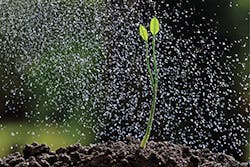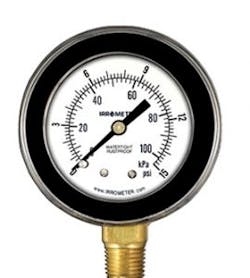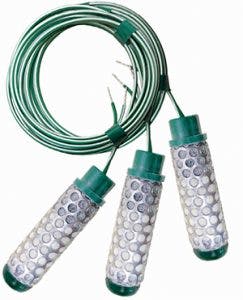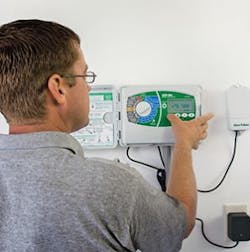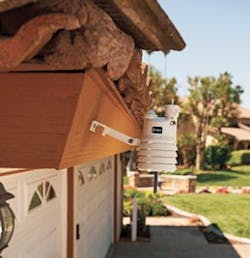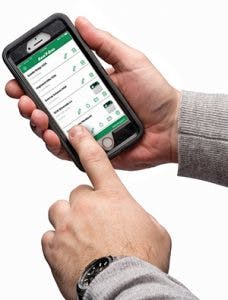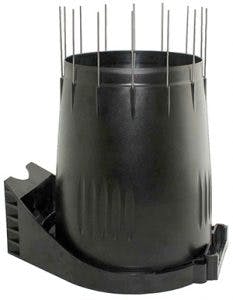The topic of irrigation begins with the question: Why are we irrigating? According to Brent Mecham, industry development director for the Irrigation Association, the answer is obvious: to keep
plants healthy.
Are they worth keeping around? “Humans have a close relationship with plants,” believes Mecham. “Plants make our environment enjoyable. In an urban landscape, they sequester carbon, provide oxygen, cool the environment (including heat island mitigation from concrete), provide noise abatement, control erosion, and attract wildlife.”
The concept of urban landscaping is a byproduct of having the right plants in the right place, he continues. “Adapted plants can get by on less water, but you still must keep them healthy. Without moisture, grass goes dormant, trees lose leaves.” Irrigation guarantees that the landscape stays alive. “Our job is to deliver water to the plants,” sums up Mecham.
However, Netafim’s John Mascoe wonders if the industry is solving the right problem. “There’s no silver bullet or technology that makes the industry smart. Just do the basics correctly: deliver the right amount of water and nutrients at the right place and time.”
That, of course, is the key to smart irrigation. Peter Carlson, chief technology officer for HydroPoint Data Systems, says that most people over-irrigate 20–30% beyond what the landscape needs. Not only does that not contribute to healthy plants, but it also wastes water, energy, and money—and in some regions, it can violate regulations.
In California, says Orion Goe, product manager for residential and commercial irrigation with Toro, “water is on our minds. It is a very limited resource—a finite resource.” Because of that, the cost for water has increased by double digits in some regions.
A gauge from Irrometer
IT’S ALL ABOUT CONTROL
The Environmental Protection Agency WaterSense program calls controllers water-saving devices. “They respond to environmental conditions and adjust appropriately,” explains Mecham. “It gets rid of human error.” He knows it’s aggravating to see irrigation when it’s raining.
The next generation of smart controllers interface with smartphones, making engagement easy. However, less than 10% of the controllers currently in use are smart. “People are reluctant to change or upgrade. There’s a reluctance to spend money if the old controllers are working.” And, because the Wi-Fi portal for commercial controllers has some weaknesses, there is added skepticism.
But, he continues, it can be cost-effective to switch to the new controllers. “There can be water savings, reduced labor, and decreased fertilizer use—with embedded energy costs.” The settings on the old controller are not weather-responsive, but the new controller reduces the amount of time for watering, saving both water and the time to treat and move water. That is not an insignificant fact. In California, 20% of the total energy is used to move water.
The cost of new controllers is not much, Mecham speculates. “They cost about the same as what they’re replacing. It’s a no-brainer; we should have used them a long time ago.”
Smart controls are required in California, and Texas is beginning to follow California’s requirements. The same is happening in the Southeast and “any dry climate,” says Rain Bird Corporation’s Greg Steele, regional sales manager. Although because the cost of water is less in Florida than in Texas and California, that state is following more slowly.
Smart controls enhance efficiency through weather-based programming and the ability to remotely manage multiple sites from one location, saving labor and fuel costs. The exact return on investment is a complicated calculation that depends on the cost of water and the location. “Labor is easier to calculate,” says Steele.
He lists smart controllers from Rain Bird that can execute basic weather-based remote scheduling, such as the new ESP-TM2 (Extra Simple Programming) for residential use. “It’s simple,” he says. “If you add the LNK Wi-Fi module thumb drive and an app, you can control it from your cell phone.”
He recommends the ESP-Me controller for residential/light commercial use (which also works with the LNK Wi-Fi), and the IQ system with add-on communications devices for light to heavy-duty commercial usage. For high-end commercial use such as schools, cities, and resorts, the Maxicom is the best choice.
Today’s controllers provide programming flexibility to improve the timing and amount of water distribution. They are also more robust, standing up to damage from rodents and weed whackers.
Sensors from Irrometer
SENSING THE NEED FOR CHANGE
Efficiency starts at the control system, states Orion Goe—especially when that controller is paired with a sensor. It’s not new technology, he confesses, but there’s been a shift in the mindset. “A multi-year drought in the West changed how people think about water. Today, there is more awareness of technology due to the internet, and a better understanding of the importance of efficiency.”
Wireless weather and wireless soil moisture sensors are the most popular, he notes, because they provide real-time weather and moisture content data that allows for immediate adjustments. Historical data is not as accurate as real-time data. “It’s backward-looking,” says Goe. Shifts in weather patterns are more common now and help drive the adoption of sensors.
Toro sensors use a proprietary radio frequency: 900 megahertz. “We have a product to integrate between the timer and the internet to the phone—an internet gateway,” details Goe. He says it has a better range using the radio than Wi-Fi and is secure, with no password or permission needed. It’s an app-based solution that can be monitored via phone or computer. The controller pulls weather data from the internet. “Using a local weather sensor is more accurate because it’s real-time. Using zip-code based weather is inaccurate and fallible.”
Rain Bird also uses weather-based irrigation programming. “It measures ET [evapo-transference], temperature, humidity, and wind speed,” says Steele. These new rain sensors are specific to California due to an ordinance that restricts irrigation within 48 hours of any measurable rainfall.
Driven by the need to save water, California instituted regulations for the use of smart controllers, explains Brian Vinchesi, design engineer, Irrigation Consulting Inc. These regulations are not required everywhere, but many more states are considering such water-saving mandates.
For a long time, a rain sensor was enough, Goe reflects. Soil moisture sensors are now popular. “A rain sensor doesn’t know the soil moisture. So even if you know the weather, you still might not know the right time to water.”
Soil moisture sensors interface with the controller; if there’s adequate moisture, they disable irrigation. By providing feedback to the controller, they help determine how long to wait after a big rain until it’s time to irrigate again.
Rain Bird’s ESP-Me controller is one of two
models currently compatible with the LNK WiFi module which allows users to manage irrigation via a free mobile app.
They originated in agricultural applications, Mecham explains, and are now used on golf courses and residential properties. Reliable and affordable, they save a lot of water. They respond to all soil types and can be retrofitted with the current controller to make the existing controller smart.
While Goe says the choice of sensor comes down to “what makes sense” and personal preference, he acknowledges that residential and commercial needs—specifically, the level and depth of data—are different. For residential applications, Toro offers the wireless Precision Soil Sensor to capture moisture levels. For commercial jobs, Goe suggests TurfGuard, which captures moisture, temperature, and salinity. “For residential accounts, you really only need temperature and solar radiation,” he explains. “For commercial applications, you want temperature, radiation, and wind speed.”
Some of the differences between residential and commercial sensors include cost, ease of use, and level of contractor knowledge. “The average commercial contractor has a higher level of irrigation; residential is done at a landscaper’s level,” elaborates Vinchesi.
They’re all the same basic sensor, insists Tom Penning, president of Irrometer Company, Inc. It just depends on what it’s connected to, such as a data logger or a radio system for ag applications. In landscaping, the sensor is automatically controlled to connect directly to the controller. Regardless, they’ve all seen improvements in accuracy, communication range (wireless), robustness, and reliability.
The technology is not new, he says. “It’s been around. It’s well-proven. The basic sensor technology is the same. It’s the devices that read it that are changing.” In agricultural applications, it’s a remote, manual read on the phone. It brings data to the farmer, not the farmer to the data. In landscaping, it’s two-wire technology integrated with Wi-Fi controllers. “We connect and adapt to interface with all of them to create a better communication system allowing the user to download data to see what the system is doing.”
Because data is read more frequently on smartphones than when manual reads are necessary, it’s easier to establish baselines, change times, and adjust the schedule. A self-monitoring app makes it even simpler, says Vinchesi.
Smart irrigation is either weather- or sensor-based. Weather sensors calculate how much to water; soil moisture sensors calculate when to irrigate. Most manufacturers say they can be combined well, at an additional cost. However, Steele says that they don’t work well together, although Rainbird’s IQ system can hook up with a third-party soil moisture. “Generally, it’s one or the other.”
An on-site weather sensor can capture a variety of data, such as real-time temperature and solar radiation.
GO WITH THE FLOW
Technology is more than just controllers, Vinchesi states. Flow sensing is a popular and less expensive method of maintaining appropriate irrigation levels. “You set the parameters—flags if too much or too little water is used.”
Because it tracks the amount of water being used, it can also be used for leak detection. Currently used in commercial applications, he says it’s quickly moving to the residential arena. “A lot of green codes require it.” Green codes are national environmental codes often adopted state-by-state and city-by-city.
One of the biggest needs in irrigation is flow management, Peter Carlson, chief technology officer for HydroPoint Data Systems, believes. Advanced flow management is a feature of WeatherTRAK OptiFlow XR, a powerful smart irrigation controller from HydroPoint Data Systems. OptiFlow XR maximizes pipe capacity and hydraulic capacity to reduce overall time by running zones. “You can figure out how much water can be put down to run max zones,” explains Carlson. He warns of liability issues when irrigating near sidewalks if too much water is put down.
This allows users to share flow information from single or multiple flow sensors across multiple controllers. It enables automatic water window optimization across groups of controllers by keeping water running as close to the site’s hydraulic capacity as possible. The controller’s eXtended Resolution capability provides high-resolution flow rates down to one-minute intervals, making it possible to visually diagnose irrigation issues without visiting the site. OptiFlow XR also gives users a host of visual tools to help simulate watering schedules and make educated management decisions.
One of the reasons the new OptiFlow is so important is that it links flow monitoring and management. The innovative aspect is its analytics: HydroPoint Performance Management. “It helps customers save water costs and get an extra 10% on leases by attracting tenants because the property looks good,” says Chris Kryzan, chief product officer.
While estimating payback in water savings in less than 2 to 3 years, Kryzan says most customers will see savings in one month, due to risk mitigation and a decrease in hardscape damage.
There are other benefits as well. “A California EPA study indicated that reducing runoff reduces intervals of parking lot re-pavement by 3 to 5 years,” relates Carlson. Less runoff waste means less environmental impact and less fertilizer used, not to mention less water used. The increasing cost of water and the cost of replacing old infrastructure are driving the need for more analytics, contributing to the trend for more visibility and control to be smarter and more efficient.
Rain Bird’s LNK WiFi module’s free
companion mobile app allows property owners and contractors to manage multiple irrigation sites remotely.
A DROP IN THE BUCKET
There are “lots of California ordinances” regarding irrigation, Steele acknowledges. For example, overhead irrigation must achieve 65% distribution uniformity—and doing so requires a high-efficiency nozzle. It’s one reason he says drip is used more than overhead. “M-line drop tubing is taking over the market due to California legislation.”
It’s a change Goe has also noticed. “People want high-efficiency devices: nozzles and drip (low volume). It’s one thing to set the time, but you also need current nozzles, not legacy nozzles. It saves water and energy.”
Rain Bird offers something new in drip irrigation: the XFSCV for sub-surface or on-grade drip irrigation, featuring Copper Shield technology for root intrusion. “A copper chip prevents root growth,” explains Steele. An integrated check valve is in each emitter to prevent drainage and runoff on a slope when the water turns off. “It doesn’t drain and empty. It holds the water.”
Delivering water at the roots uses less nitrogen and phosphorous and is more efficient. Growers can achieve a 30–40% increase in efficiency with a sub-service drip irrigation system.
UNDER PRESSURE
One way to prevent runoff is to put down only the amount of water needed. Pressure regulation on spray heads saves water by controlling how much water is released. They fit inside a sprinkler to control the water pressure. “It’s not popular,” reveals Vinchesi, “but new green codes require it.”
Most pop-up sprinklers work best at 30 psi, but are often set at 50–60 psi. “If you run the spray sprinkler at 60 psi vs 30 psi, it uses 41.4% more water,” continues Vinchesi. “Contractors don’t like [pressure regulators] because they cost more, but they understand them.”
Pressure regulators cost more, but the payback is fast, Mecham counters. Despite that, and the fact that they’ve been around for 15 years, he says less than 10% have pressure regulation. However, the market has grown in the last couple years.
Putting down the right amount of water also helps drought conditions. HydroPoint recently announced a new communication offering to assist with that. “[It’s] a new spray head technology that increases the time needed to put water on the landscape,” says Carlson. HydroPoint’s multi-stream, multi-spray (streams vs. mist) puts down water in the right place, but it takes longer, he explains. “It’s a compliance factor. You can adjust or shift the percentage to “drought green” to manage water distribution appropriately.”
How and when water is applied matters. In some areas, the time of day allowed for irrigation is regulated. In others, it’s more a question of weather. But, because irrigation typically occurs at night, it’s important to know the weather data for the past 24 hours and irrigate accordingly. Forecasts are not always reliable, based on what recently occurred, Carlson warns. In addition, because people don’t usually watch irrigation at night, if there’s a leak or break, no one sees it.
HydroPoint offers a mobile web app that provides instant, current data for remote management. “We run our own climate center and do our own data collection for any microclimate,” says Carlson. It provides ET weather data, water distribution data, information about the behavior of the controller, and preferences.
Next, integrated flow sensors monitor how much water is put down and can shut off if there’s a catastrophic event. They mitigate leaks and breaks and get water down in the prescribed window, Carlson points out. “That’s especially important for commercial irrigation.”
A rain gauge from Irrometer
WATER UNDER THE BRIDGE
Residential and commercial applications are very different, Vinchesi states. Internet-based apps are very popular with residential clients, but commercial clients prefer sensor-based systems that remotely monitor soil moisture and climate (although weather-based systems are less popular than soil moisture-based systems).
The drivers are different. For production, increasing yield and saving labor and time are important, Penning observes. For landscapers, conservation is critical. For residential, it’s all about costs. That’s why utilities incentivize with tiered billing to encourage homeowners to save money by saving water. Commercial accounts generally respond to regulations.
No matter who the customer or what the system is capable of doing, when and how long it runs is what counts. In drought conditions when the water supply is further limited, you have to be even more efficient. It’s a situation we will be faced with again and again.
“Water tables are dropping,” states Penning. “We must figure out how to be more efficient by not irrigating more than needed.” Over-irrigating leads to fungus, plant health problems, pests, disease, and added cost to treat and transport the water.
He thinks that most inefficient systems result in over-watering and that the systems should be checked to improve efficiency. “There’s no silver bullet; look at the whole system.” Repairing or replacing a system can result in savings of 30–70%. “With a weather-based control system, there’s a 10% differential,” points out Penning. “There’s a big chance for improvement for small labor. The cost of hardware is paid for with the cost of water.”
Never forget the connection between water and energy. California constantly looks at energy. Regulations introduced in that state have resulted in 20–30% less water going through sprinklers. Some jurisdictions mandate the use of water conservation programs, Mecham says.
The EPA WaterSense program released a label much like the Energy Star program to indicated products (such as controllers) that save water. “It will be a significant change in the marketplace,” predicts Mecham.
KEEP IT SIMPLE
The industry wants reliable, cost-effective solutions that are simple, Netafim’s Mascoe says. “It’s not complicated technology; the radio and sensor are proven technology.” They collect and store data to determine what a plant needs at any given time.
In fact, he claims there’s been nothing innovative introduced in 20 years. It’s more about adopting the technology than the technology itself. “We’re just finding a better way to apply the technology and deliver water.” Doing so has increased yields and decreased costs 30–60%.
“You can’t put stuff in the ground and forget it,” continues Mascoe. “It’s not automatic, it’s not maintenance-free. But people want to simplify.” He says the ability to monitor and control the delivery system to improve efficiency and energy use helps users focus on other things. “Monitoring allows the grower to get the basics right: no automatic watering.”
THE FORECAST
Steele says he can’t imagine anything brand new, any game-changer in irrigation—“just improvements, more options, fine-tuning…”
Penning, however, says Irrometer has new cellular radio technology coming out in the next few years that is faster, has a longer range, operates at a lower power, and requires less data usage.
Sometimes, what’s old is new again. Vinchesi says two-wire technology is making a comeback. What was a disaster in the 1960s has become “extremely popular” in this century. Although it requires more grounding and is more sensitive, it is also less expensive, requiring less wire. “You have to be good at splicing and tracking, but the sensors are easier to attach to it; the soil sensor and irrigation go on the same wire.” It’s simpler, he says—and it’s changing the market.
Expect more sensing at a lower cost, Vinchesi predicts. Expect more feedback and decisions made automatically. “It will be more commonplace as everyone is looking at sensors to adjust their scheduling.”
You can also expect more things that can be sensed: flow, wind, temperature, soil moisture, salinity, soil temperature, and more. “Moisture scares people,” observes Vinchesi. “You must have knowledge [to use it], but it’s popular in regulations and green codes because it saves more water than climate sensors and it’s more accurate.”
Goe anticipates more integration of technology, particularly from a location-based standpoint. “We will program by longitude and latitude, incorporating the deliberate collection and aggregation of building data to make systems smarter. The system will tell us how long it needs to run, based on variables (such as the type of grass) after a one-minute run.”
He says we already collect an overwhelming amount of data. “What do we do with it? We’ll figure that out one day.”
That’s why the future belongs to the water manager who understands analytics and watches for trends, Carlson believes. But whatever developments smart technology brings in managing water, he says the cost of water will go up as scarcity increases.
“Water historically was thought to be infinite with little cost,” concurs Kryzan. “Five to 10 years ago, aquifers were being drained because the supply seemed unlimited.”
We think differently now. We know water is a precious resource, with costs associated for treatment, transportation, and acquisition. Businesses are incorporating water savings as part of their business plan. “The cost of water is driving savings,” says Kryzan. It’s also driving innovations for smart technology in irrigation.
